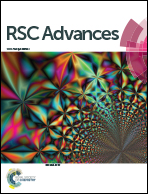The removal of heavy metal ions from aqueous solutions by amine functionalized cellulose pretreated with microwave-H2O2
Abstract
A new biosorbent (PEI/SA-MCCMV) with abundant amino and carboxyl groups was prepared by grafting polyethylenimine (PEI) onto carboxylated microcrystalline cellulose (SA-MCCMV), which was obtained through grafting succinic anhydride (SA) on pretreated microcrystalline cellulose (MCCMV) with microwave-H2O2. It was confirmed by Fourier transform infrared spectroscopy (FT-IR), scanning electron microscopy (SEM), X-ray photoelectron microscopy (XPS) and thermogravimetric (TG) that the amino and carboxyl groups were introduced onto the microcrystalline cellulose, and the amino and carboxyl groups content were 2.61 mmol g−1 and 4.64 mmol g−1, respectively. The effects of the contact time and pH on heavy metal ion uptake were investigated. The adsorption kinetic data was described well with the pseudo-second-order model (R2 > 0.99) and the adsorption isotherms were well fitted by the Freundlich isotherm model, demonstrating that chemisorption was the rate-controlling factor for heavy metal ion adsorption on the PEI/SA-MCCMV biosorbent. Furthermore, the remarkable adsorption capacity (217.3 and 357.1 mg g−1 for Cd(II) and Pb(II), respectively) obtained from the Langmuir isotherm indicated that this biomass adsorbent has a promising application in water treatment.



 Please wait while we load your content...
Please wait while we load your content...